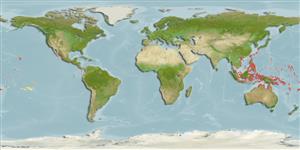Common names from other countries
Environment: milieu / climate zone / depth range / distribution range
Ecologia
marinhas associadas(os) a recifes; não migratória; intervalo de profundidade 0 - 3 m (Ref. 30874). Tropical; 30°N - 18°S
Western Pacific: southern Japan south to northern Queensland, Australia. Has been collected close to the islands in Micronesia, Melanesia, Fiji and New Guinea.
Tamanho / Peso / Idade
Maturity: Lm ? range ? - ? cm
Max length : 6.4 cm TL macho/indeterminado; (Ref. 117049)
Espinhos dorsais (total): 4 - 6; Raios dorsais moles (total): 8-13; Espinhos anais 1; Raios anais moles: 13 - 15. Mouth barely protractile and with thin lips. Basihyal and mesopterygoids usually with teeth. No notch present at the anterior border of preopercular bone. Face with Shangreen denticles. Ascending process of premaxilla with no lateral processes present. Distal end of maxilla blunt and truncate.
Loose aggregations inhabit tide pools and rocky shorelines and reef margins. Eggs are large.
Life cycle and mating behavior
Maturidade | Reprodução | Desova | Ovos | Fecundidade | Larvas
Myers, R.F., 1991. Micronesian reef fishes. Second Ed. Coral Graphics, Barrigada, Guam. 298 p. (Ref. 1602)
Categoria na Lista Vermelha da IUCN (Ref. 130435)
CITES (Ref. 128078)
Not Evaluated
Ameaça para o homem
Harmless
Utilização humana
Pescarias: sem interesse; isco: occasionally
Mais informação
ReferênciasAquaculturaPerfil para aquaculturaEstirpesGenéticaElectrophoresesHereditariedadeDoençasProcessamentoMass conversion
ColaboradoresFotografiasStamps, Coins Misc.SonsCiguateraVelocidadeTipo de nataçãoÁrea branquialOutras referênciasCérebrosVisão
Ferramentas
Relatórios especiais
Descarregue XML
Fontes da internet
Estimates based on models
Preferred temperature (Ref.
115969): 26.2 - 29.3, mean 28.7 (based on 1520 cells).
Phylogenetic diversity index (Ref.
82804): PD
50 = 0.6250 [Uniqueness, from 0.5 = low to 2.0 = high].
Bayesian length-weight: a=0.00389 (0.00180 - 0.00842), b=3.12 (2.94 - 3.30), in cm Total Length, based on all LWR estimates for this body shape (Ref.
93245).
Nível Trófico (Ref.
69278): 3.4 ±0.45 se; based on food items.
Fishing Vulnerability (Ref.
59153): Low vulnerability (10 of 100).
